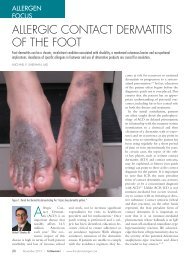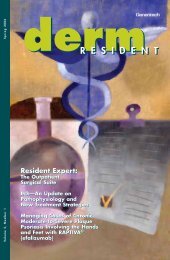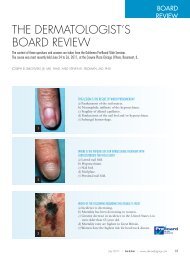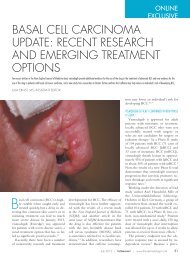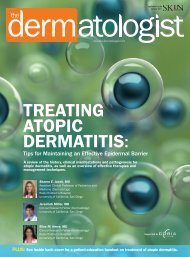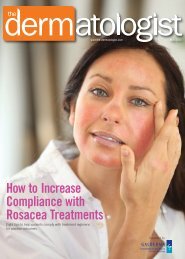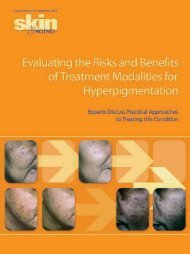Download PDF - The Dermatologist
Download PDF - The Dermatologist
Download PDF - The Dermatologist
Create successful ePaper yourself
Turn your PDF publications into a flip-book with our unique Google optimized e-Paper software.
FA L L C L I N I C A L D E R M AT O L O G Y C O N F E R E N C E P R O C E E D I N G S<br />
IS IT REALLY ROSACEA?<br />
A DISCUSSION OF DIFFERENTIAL DIAGNOSES, TREATMENTS<br />
AND ADVANCES IN RESEARCH<br />
BY JOSEPH BIKOWSKI, M.D.<br />
BIKOWSKI SKIN CARE CENTER<br />
SEWICKLEY, PA<br />
<strong>The</strong>re have been few, if<br />
any, new systemic or topical<br />
medications developed<br />
in the last few years for the<br />
treatment of rosacea, so oftentimes,<br />
advancement in therapy<br />
relies upon the correct diagnosis.<br />
<strong>The</strong> right medicine will not work<br />
with the wrong diagnosis. For<br />
Joseph Bikowski, M.D. every individual who pre s e n t s<br />
with a red, scaly face, the dermatologist<br />
will consider the differential diagnoses: rosacea, seborrheic<br />
dermatitis, irritant contact dermatitis, allergic contact<br />
dermatitis, etc. Is it really rosacea? Are there other things that<br />
can look like rosacea?<br />
D I F F E R E N T I A L DIAGNOSES AND UNUSUAL<br />
FACES OF ROSACEA<br />
D e m o d ex d e r m a t i t i s . When patients present with red, scaly<br />
faces, the first consideration is whether there is an “infectious”<br />
component or an infestation that can be cured or suppre s s e d<br />
for a prolonged period of time. Cases of D e m o d e x d e r m a t i t i s<br />
can be treated with permethrin (Elimite) or crotamiton (Eurax)<br />
twice daily, morning and night, for 2 to 4 weeks.<br />
Case 1. A patient had been treated for almost 2 years for<br />
rosacea and then seborrheic dermatitis without improvement<br />
(Figure 1). A potassium hydroxide (KOH) preparation revealed<br />
Demodex. Because no other treatment had been effective,<br />
the patient was started on Elimite twice daily, and within 2<br />
weeks, his face cleared. <strong>The</strong> red, scaly rash over his forehead,<br />
nose and malar eminence disappeared. <strong>The</strong> patient<br />
remained clear at 1-year follow-up.<br />
Rosacea, seborrheic dermatitis and D e m o d e x d e r m a t i t i s<br />
can exist separately or together. Oftentimes, the red scaling<br />
is not seborrheic dermatitis with rosacea or seborrheic<br />
dermatitis alone. Rather, it may be D e m o d e x d e r m a t i t i s .<br />
Patients in whom the diagnosis of rosacea is suspected<br />
should have KOH preparations performed on scrapings of<br />
the scales from their faces and empirical treatment with<br />
either Elimite or Eurax twice daily, morning and night, for 2<br />
weeks. Individuals who are not improving with anti-ro s a c e a<br />
therapy or anti-seborrheic dermatitis therapy who still have<br />
red, scaly faces should receive one of these topicals twice<br />
daily for 2 to 4 weeks.<br />
Steroid use/abuse/misuse dermatitis. Another unusual<br />
p resentation that may resemble rosacea is stero i d<br />
use/abuse/misuse dermatitis. Any cortisone molecule used<br />
frequently over a long period of time in a susceptible individual<br />
can produce steroid use/abuse/misuse dermatitis.<br />
Case 2. A 26-year-old woman presented with an<br />
intensely pruritic, erythematous, scaly, papular eruption of 6<br />
months’ duration on her face (F i g u re 2). For that period of<br />
time, she had been applying a topical corticosteroid to her<br />
face 4 times daily. <strong>The</strong> steroid responsible for this was<br />
0.5% hydrocortisone cream.<br />
PATIENTS IN WHOM THE DIAGNOSIS<br />
OF ROSACEA IS SUSPECTED SHOULD<br />
HAVE KOH PREPARATIONS<br />
PERFORMED ON SCRAPINGS OF THE<br />
SCALES FROM THEIR FACES.<br />
Plaque ro s a c e a . <strong>The</strong> usual presentation for rosacea is erythema,<br />
papules and pustules on the central third of the face.<br />
H o w e v e r, there is a presentation called plaque rosacea in which<br />
erythema, edema, papules and pustules appear only in one isolated<br />
area, ie, on one cheek (F i g u re 3). <strong>The</strong>se patients re s p o n d<br />
to rosacea therapy, especially systemic therapies.<br />
8 • M A R C H 2 0 0 8 • S U P P L E M E N T T O S K I N & A G I N G



